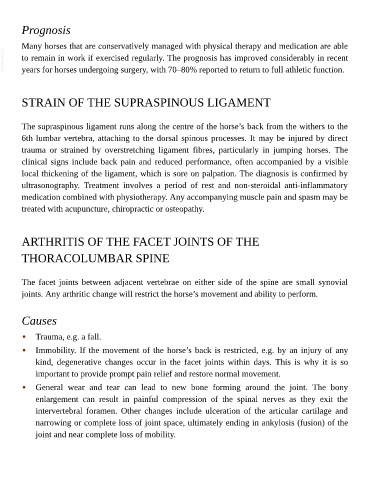Page 570 - The Veterinary Care of the Horse
P. 570
Prognosis
Many horses that are conservatively managed with physical therapy and medication are able
VetBooks.ir to remain in work if exercised regularly. The prognosis has improved considerably in recent
years for horses undergoing surgery, with 70–80% reported to return to full athletic function.
STRAIN OF THE SUPRASPINOUS LIGAMENT
The supraspinous ligament runs along the centre of the horse’s back from the withers to the
6th lumbar vertebra, attaching to the dorsal spinous processes. It may be injured by direct
trauma or strained by overstretching ligament fibres, particularly in jumping horses. The
clinical signs include back pain and reduced performance, often accompanied by a visible
local thickening of the ligament, which is sore on palpation. The diagnosis is confirmed by
ultrasonography. Treatment involves a period of rest and non-steroidal anti-inflammatory
medication combined with physiotherapy. Any accompanying muscle pain and spasm may be
treated with acupuncture, chiropractic or osteopathy.
ARTHRITIS OF THE FACET JOINTS OF THE
THORACOLUMBAR SPINE
The facet joints between adjacent vertebrae on either side of the spine are small synovial
joints. Any arthritic change will restrict the horse’s movement and ability to perform.
Causes
• Trauma, e.g. a fall.
• Immobility. If the movement of the horse’s back is restricted, e.g. by an injury of any
kind, degenerative changes occur in the facet joints within days. This is why it is so
important to provide prompt pain relief and restore normal movement.
• General wear and tear can lead to new bone forming around the joint. The bony
enlargement can result in painful compression of the spinal nerves as they exit the
intervertebral foramen. Other changes include ulceration of the articular cartilage and
narrowing or complete loss of joint space, ultimately ending in ankylosis (fusion) of the
joint and near complete loss of mobility.

